Ashley Horn’s The Long Stay—The Pilot Dance Project

All photos by Pin Lim
The Pilot Dance Project began its new season of projects by various choreographers with a site specific performance created by Ashley Horn. The Long Stay took place across three floors and several rooms in the distinguished downtown edifice known as the Hotel Icon. There were five performances across one Saturday afternoon, start times between 1:00pm and 7:00pm.
The audience gathered in the Icon’s stately lobby until we were instructed to follow up one flight of stairs. At the top of the stairs, we passed a sitting room from which filed more than a dozen elegantly dressed performers, all in sparkling evening gowns of different colors—indeed such gowns were the costume for the whole performance, although many wardrobe changes were made throughout. A short distance, around a corner, we found ourselves in a second floor lobby, where the performers slipped off their high heels and began dancing in groups, and solos. The initial soundtrack was full of vocals without words—all “ahs” and “ohs” to introduce an ethereal theme. This music gave way to a more percussive music, to which the dancers performed choreography that was alternately bouncy and sensuously sinewy. They slipped back into their shoes and slipped around the corner and were gone from our sight.
At that point, we had our curtain talk and the audience was divided into two groups, with red or blue threads on our wrists. The groups were led to elevators where we were taken to the fourth floor and the beginning of a tour of individual rooms.
What follows is a brief description of what happened in each room. My hope is the description will evoke some of what we experienced.
Room 410
 The room is full, 12 performers sitting the edges of the bed or on chairs. They’re all dressed in black, now. Most of them roll from their seated positions to sit on the floor, leaning against the bed or chairs, heads resting in the cradles of their bent elbows. One performer rises and, one by one, touches the back of each sleeping dancer. Once awake they perform choreography that is mostly gestural—so many performers in so small a space would allow for little else. The hands, however, are precise. I’ve seen it before in Ashley’s choreography, how distinct her gestures are. They are not pantomime. They are widely open to interpretation, but neither are these hands wandering aimlessly. Duets are danced on the bed, mostly on knees, until all eventually return to their sleeping positions. The one performer goes around, waking them again, and they file out of the room. We’ve entered the dream, full of detail and rich in slippery meaning.
The room is full, 12 performers sitting the edges of the bed or on chairs. They’re all dressed in black, now. Most of them roll from their seated positions to sit on the floor, leaning against the bed or chairs, heads resting in the cradles of their bent elbows. One performer rises and, one by one, touches the back of each sleeping dancer. Once awake they perform choreography that is mostly gestural—so many performers in so small a space would allow for little else. The hands, however, are precise. I’ve seen it before in Ashley’s choreography, how distinct her gestures are. They are not pantomime. They are widely open to interpretation, but neither are these hands wandering aimlessly. Duets are danced on the bed, mostly on knees, until all eventually return to their sleeping positions. The one performer goes around, waking them again, and they file out of the room. We’ve entered the dream, full of detail and rich in slippery meaning.
Room 412
Two women sit at the head of the bed in a darkened room. They’re watching TV. They get up and turn on two empty film projectors. They return to the bed and sit in the squares of white light. They have become TVs. They turn to each other. They appear to be fixing each other’s hair or makeup. In their tenderness to one another, I detect a hint of sad encouragement. They move to the floor and dance with large, sweeping movements. Even only two dancers fill the available space but allowed for gestures suggesting release of pent-up energies. Whether they were still in/on TV or moved into an external existence, I wouldn’t say, but they finally turn off the projectors and again sit quietly at the head of the bed.
Hallway
Dancers quietly move along and against the walls. During the performance I attended, a bellhop and real life hotel guests passed through, concretizing the site of this performance. We were not on a set constructed for this event.
Room 308
 Ushered down one floor, we entered a room with two dancers kneeling on the bed, dressed all in white. The edges and foot of the bed are lined with tangles of white Christmas lights. The performers arms touch and entwine, but one seems distracted, nearly oblivious to the second. The second leads almost all the interaction. The second’s eyes focus on the first, but the focus is not returned. The TV plays old commercials. A new 1983 Nissan. A country music radio station. Sara Lee desserts. The second grabs the first’s wrist, pushes and pulls. There is a flash of returned interest. They remove their abundant skirts and slide under the bedcovers. The second turns away and lays down as to sleep. The first pauses, then mirrors the action. They sleep back to back.
Ushered down one floor, we entered a room with two dancers kneeling on the bed, dressed all in white. The edges and foot of the bed are lined with tangles of white Christmas lights. The performers arms touch and entwine, but one seems distracted, nearly oblivious to the second. The second leads almost all the interaction. The second’s eyes focus on the first, but the focus is not returned. The TV plays old commercials. A new 1983 Nissan. A country music radio station. Sara Lee desserts. The second grabs the first’s wrist, pushes and pulls. There is a flash of returned interest. They remove their abundant skirts and slide under the bedcovers. The second turns away and lays down as to sleep. The first pauses, then mirrors the action. They sleep back to back.
Room 314
Rippling light is projected on the wall behind the bed’s headboard. The soundtrack playing could be crashing waves or rolling thunder. One dancer opens and closes a curtain. A trio at the foot of the bed, on the floor, exchange partnering duties, sharing weight and space. A duet emerges along the wall with the windows. They lean and push against it. They invert as feet climb the wall. The lines between the groups are permeable as they seep in and out of solos, duets, and trios.
Room 316
Three performers in white are on the floor. One dress all in black sits on the bed, coolly watching. Here is more of the precise gesturing but this time approaching something more literal while still allowing for ambiguity. Fingers touch lips and pull away expansively—applying lipstick or smoking? A hand repeatedly cups the lower abdomen—sex, sickness, pregnancy?
Hallway
Here we find a lone dancer in a white dress with generous skirts. The dancer handles all the fabric vigorously. The emotion is unclear or else morphs quickly between excitement, anger, and frustration. It would be easy to see the character as a bride on a troubled wedding day, but there are other possibilities.
Room 310
 A solo dancer paces as the opening strains of Dolly Parton’s “Here You Come Again” begin to play. The dancer, all in pink, is in the room’s narrow entryway (the worst sightlines of the whole show, but we all seemed to manage). She looks out the peephole, then runs into the room, opens the curtains on a window, looks out. She grabs a sitting stool and takes it into the entryway to barricade the door. She’s agitated, nervous. She grabs a trashcan and adds it to the barricade. The stool and can’s combined weight wouldn’t have stopped a determined toddler, but it was all that was at hand. She looks out the peephole again. She appears to reach a resignation as she un-barricades the door, crosses the room to close the curtains. As the song comes to an end, she hides under the writing table beside the bed.
A solo dancer paces as the opening strains of Dolly Parton’s “Here You Come Again” begin to play. The dancer, all in pink, is in the room’s narrow entryway (the worst sightlines of the whole show, but we all seemed to manage). She looks out the peephole, then runs into the room, opens the curtains on a window, looks out. She grabs a sitting stool and takes it into the entryway to barricade the door. She’s agitated, nervous. She grabs a trashcan and adds it to the barricade. The stool and can’s combined weight wouldn’t have stopped a determined toddler, but it was all that was at hand. She looks out the peephole again. She appears to reach a resignation as she un-barricades the door, crosses the room to close the curtains. As the song comes to an end, she hides under the writing table beside the bed.
Room 308
There are not live performers here this time. Instead, we watch a video of a solo dancer, dressed in white on a wooded path. Sneakered feet slide and kick away leaves, dirt and pebbles. The dancer and the otherwise empty path are the only signs of humanity. This is a nice interlude for contrasting specific sites—an urban downtown hotel room with traffic just below and a nature trail bordered by abundant woodlands.
Room 312
The Hotel Icon’s rooms have a somewhat unique feature: a window between the bathroom the main room. The bathtub is directly below the window on the bathroom side. Here we enter to find a performer sitting in the window, watching the TV. She turns off the TV and enters the main room, dressed all in blue. The dance she performs is slow, sinewy. She bows low and her fingers crawl painstakingly across the floor, dragging the palms of her hands—more of the small, precise gestures. There is strength and struggle in the dancer, sadness and hope.
I failed to record the last room number we entered, but here, again, we find a performer seated in the bathroom window. This is Natasha Manley, a singer and musician. Her voice carries us to the performance’s conclusion, singing a song of her own composition. “See me and tell us of the cradle of your heart.” Crowded into the main room are the other performers who file out the room, pausing by Natasha to lay an object on the windowsill beside her. A bell, a bracelet, a spoon, a small book, a piece of lace, a pair of scissors, and more.
 Hotels are particular things. They are not home and are seldom their own destination. They’re a place to sleep and clean up while doing other things in a place-not-home. They’re a stop along the way to someplace else. People pause there, maybe to briefly hide.
Hotels are particular things. They are not home and are seldom their own destination. They’re a place to sleep and clean up while doing other things in a place-not-home. They’re a stop along the way to someplace else. People pause there, maybe to briefly hide.
Ashley Horn played with all this and more with her expansive yet small-spaced dance performance. Moving room to room as we did, there was the feeling of a tour, but also a sense of voyeurism. The audience didn’t interact with the performers, only watched. It sometimes felt like a dream, other times like a haunting. In a place where people mostly go to sleep, the walls of a hotel must be steeped in dreams, but maybe also ghosts of past guests and their lives. Perhaps that’s the “long” of the The Long Stay, these things that are left behind like a piece of lace dropped on the way out. One has to ask, though, who are the ghosts and who are the living? Were the performers manifesting past experiences within these walls or were the audience members haunting current tenants? Hauntings are vague like that.
This was performance for close viewing. The small gestures, the subtle emotions, would have been lost on a large stage, to a large audience. And yet I would wish more people could experience this brief wonderland Ashley created. That there were five performances across and afternoon made me wonder about the way the light in the room changed—I would think what I saw at 2:30 must have been different from the last show at twilight. Which would have the most haunting, the better dreaming? A darkened room with sunlight in the cracks of the curtains or with streetlights coming on?
“See me and tell us of your fear and of your shame,” Natasha bids us at the end. Her haunting melody and fluid vocals wrap up the performance with hints of more dreams possible in the sharing. Perhaps some exorcisms, too.



Neil, this is such lovely and evocative reporting! Thank you for taking me to an event I could not take myself to.
Thank you for the comment. It was a beautiful performance. I hope they are able to re-stage it at some point, as more people should have the opportunity to see it.